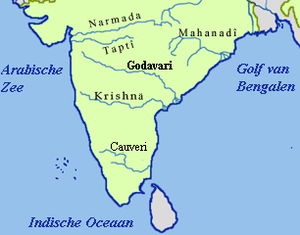Pulichinthala Project
| పులిచింతల ప్రాజెక్ట్ | |
|---|---|
 Location of పులిచింతల ప్రాజెక్ట్ in India | |
| Official name | K.L Rao Sagar |
| Location | Between Suryapet district, Telangana and Guntur District, Andhra Pradesh |
| Coordinates | 16°45′15″N 80°03′24″E / 16.75417°N 80.05667°ECoordinates: 16°45′15″N 80°03′24″E / 16.75417°N 80.05667°E |
| Opening date | 7 December 2013 |
| Construction cost | 1850 crore rupees |
| Dam and spillways | |
| Impounds | Krishna River |
| Height | 42.24 m |
| Length | 2,922 m |
| Width (base) | 31 m |
| Spillway capacity | 10 lakh cusecs |
| Reservoir | |
| Creates | Pulichinthala |
| Total capacity | 46 tmcft |
| Active capacity | 36.23 tmcft |
| Catchment area | 240,732 sq.km |
| Surface area | 144 sq.km |
| Power station | |
| Operator(s) | TSGENCO [1] |
| Commission date | 22.09.2016 |
| Hydraulic head | 25 Meters |
| Turbines | 4 × 30 MW Kaplan turbine |
| Installed capacity | 120 MW |
Pulichintala Project called as KLRao Sagar multipurpose irrigation project is a multi purpose project serving irrigation needs, hydro power generation and flood control. It is a crucial irrigation facility for farmers of four coastal districts of West Godavari, Krishna, Guntur and Prakasam where irrigation facility for 13 lakh acres. It has 24 gates in all with balancing reservoir with a capacity of 46 tmcft.[2] The project started impounding the water in August 2014.[3] The cost of the project has exceeded Rs.1850 crores.
History
The project was first conceived in 1911 by British engineer Col Ellis. The foundation stone was laid by the then Chief Minister, N. T. Rama Rao on 13 November 1988 at a projected cost of 188 crores.[4] It was the first project to start under the ambitious Jalayagnam in the year 2004-05. which has been started by Y. S. Rajasekhara Reddy, the then chief minister of Andhra Pradesh. . It was opened on 7 December 2013 by Chief Minister of Andhra Pradesh, Kiran Kumar Reddy.[5] Pulichintala project is located in Guntur District, Andra Pradesh State.
Location
It is located in Pulichintala village in Guntur district and Nemalipuri village on left bank side of the river in Suryapet district of Telangana state across the Krishna River,[6] between Prakasam Barrage at Vijayawada and the Nagarjuna Sagar dam.
Storage
It has 30 Tmcft live storage capacity to impound the Krishna river flood waters generated from the catchment area located downstream of Nagarjunasagar Dam. This reservoir provides timely water supply needed by Prakasam Barrage minimising Krishna water wastage to the sea. Water to the Prakasam Barrage can be supplied from Pattiseema lift / Polavaram irrigation canal during monsoon months only when there is water shortage in Pulichintala reservoir.
A lift canal irrigation scheme (near 16°42′44″N 80°00′29″E / 16.71222°N 80.00806°E) drawing water from the Pulichintala reservoir for irrigation in Nalgonda district is under implementation.[7] The proposed Yadadri Thermal Power Plant would also draw its water needs from the reservoir.
A low level lift canal from the Krishna river located near 16°42′50″N 80°08′24″E / 16.71389°N 80.14000°E at 20 m MSL in the downstream of Pulichintala dam will be executed to feed Godavari water diverted from Polavaram Dam to some of the existing command area (situated below 60 m MSL) under Nagarjuna Sagar right bank canal to facilitate extension of Nagarjuna Sagar right bank canal connecting to Kandaleru feeder canal / Somasila reservoir for serving irrigation needs in Prakasam, Potti Sriramulu Nellore and Chittur districts including Chennai drinking water supply. A branch from this lift canal is also extended up to Pulichinthala dam (FRL 53.34 m MSL) to store Godavari water in Pulichintala reservoir during drought years and to irrigate low lands along Krishna river up to Pulichintala dam.[8]
Power project
A 120 MW hydro electric plant (4*30 MW) owned by TSGENCO and first unit is commissioned on 22.09.2016 successfully. 2nd unit is in final stage of erection and it may be commissioned in December 2016. Remaining 2 units will take 1 year time to commission [9]
See also
References
- ↑ "Status of Hydro Electric Projects under Execution for 12th Plan & beyond" (PDF). Retrieved 30 June 2014.
- ↑ "Pulichintala D06327". Retrieved 30 June 2014.
- ↑ "Engineers complete trial run of Pulichintala Project". Retrieved 16 August 2014.
- ↑ http://articles.timesofindia.indiatimes.com/2002-01-07/hyderabad/27123919_1_prakasam-barrage-pulichintala-krishna-delta
- ↑ http://www.deccanchronicle.com/130710/news-politics/article/pulichintala-project-august-15
- ↑ "Pulichintala project progress report, APGenCo". Retrieved 15 May 2013.
- ↑ "KCR, Harish Rao lying on Pulichintala issue: Uttam". Retrieved 28 September 2016.
- ↑ "Pulichintala, a capital saviour". Retrieved 7 September 2016.
- ↑ "Status of Hydro Electric Projects under Execution for 12th Plan & beyond" (PDF). Retrieved 30 June 2014.
